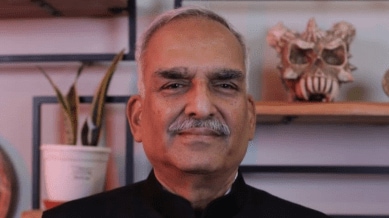Stay updated with the latest - Click here to follow us on Instagram
‘Myth that encounter specialists ended underworld had to be dispelled’: Former Mumbai top cop D Sivanandhan on how MCOCA was crucial in combating crimes
Former Mumbai police commissioner D Sivanandhan says that violent crimes have come down, cybercrimes are reporting significant financial losses.

Former Mumbai police commissioner D Sivanandhan speaks to The Indian Express about his book The Brahmastra Unleashed, in which he gives an account of how the Mumbai police, and specifically the crime branch that he headed as joint commissioner (1993–1995 and 1998–2001), brought down the underworld that was reigning in the city in the 1990s.
Q. Among the factors that helped bring down the underworld in Mumbai, why do you call the Maharashtra Control of Organised Crime Act (MCOCA) the Brahmastra?
monthly limit of free stories.
with an Express account.
Sivanandhan: Over the years, whether in Bollywood, the media, or OTT platforms, they have unnecessarily glorified encounter specialists. We all know what happened to them and how they transgressed the rule of law, paying the price.
The myth attached to encounter specialists all over the country, even today, in places like UP and Chennai, is one I wanted to dispel officially. Hence, the first-person account of how we dismantled the underworld is important to ensure the myth of the encounter specialists does not become permanent.
Q. How did MCOCA help the downfall of the underworld?
Sivanandhan: In MCOCA, we enacted a powerful law with stringent sections, including no easy bail, and effectively implemented it in its entirety. The first MCOCA was applied in the murder attempt on former Mayor Milind Vaidya, in which we secured a conviction.
Getting convictions in cases of powerful people, too, like Bharat Shah, sent a shiver down the spine (of the criminals) and a message that those mingling with the underworld will face the law.
It also helped establish the faith of people as MCOCA is a law, not a shortcut. Shootouts had been ongoing for a long time, but they had not yielded much result. After we applied MCOCA along with other measures, things came under control, and I left in 2001. From 2002 onwards, zero encounters took place until the recent killing of Baba Siddique (in 2024), which is a very long time.
Q. Did MCOCA work in isolation, or were there other factors which helped?
Sivanandhan: When you have a fever, you take so many measures, and some of them help. Even in the case of the underworld, a combination of all factors, like seizure of arms, detention of those with criminal tendencies, helped along with MCOCA.
It was a multi-pronged attack on the evil presence of the mafia. We had 1,600 man-years of detention during that time, which put away 1,600 people for a year. A shootout or even 100 cannot have such an impact.
Q. Did the police get support from politicians and courts at that point?
Sivanandhan: Political support will come only when it (the pressure) comes to them. Nearly five members of the ruling party were shot dead by gangsters. I described an incident in the book when I took charge as joint commissioner (crime) in the Mumbai police in 1998, 101 businessmen were shot dead in one year.
Nearly 800 trade representatives assembled at Birla Krida Kendra. They showered abuses on the collapsing law and order in the presence of the then CM Manohar Joshi (and his deputy) Gopinath Munde, the DGP and the Mumbai police commissioner. They threatened to celebrate black Diwali and not pay taxes.
Given the state of law and order, the Government of India could have invoked Article 356 of the Constitution to dismiss the state government. Hence, the state government had to save itself, and there had to be self-interest for such power to be vested in the police; hence, they fell into that mode.
Q. What do you think led to such a firm grip of the underworld on Mumbai?
Sivanandhan: Allowing things to happen over a long time. The same thing happened with the Chicago mafia, Italian mafia, and Japanese mafia. Accumulated power, which manifests itself someday and becomes draconian, along with connivance, corruption and political patronage built up from the 1950s. We removed a system that entrenched itself very strongly.
Q. How do you see the crime scene today?
Sivanandhan: All gangs are alive even today, but the violent crime that they were doing, like extortion and murder, does not exist; the faith in the government is alive. Now there are other issues like sand mafia, land mafia, water mafia, narcotics, and there are agencies dealing with them. They do not endanger businessmen and people like they did in the 1990s, though.
Q. Cybecrime has become a major issue today…
Sivanandhan: Cybercrime is a bloodless crime that leaves people alive but not dead. Stupid things like digital arrest that don’t exist are used to dupe educated well-heeled victims. I have taken 500–600 cybercrime lectures across the country but people think it will not happen to them.
The alleged amount lost to cybercrime is Rs 22,845 crore, and this year, a 25 per cent increase is expected. With such a large amount of money, why do you need a gang?
Q. Lastly, actor Mohanlal portrayed you in the 2002 movie Company based on the Mumbai underworld. Did you like it?
Sivanandhan: Tremendously. I liked the portrayal but obviously it is a movie and not a documentary, so not all facts are in place. (Director) Ram Gopal Varma had consulted me to get the proper look, behaviour and approach. Mohanlal did a very good job.